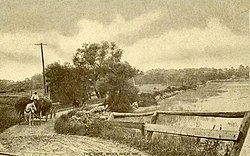Woolwich, Maine
| Woolwich, Maine | |
|---|---|
| Town | |

Country scene in 1912
|
|
| Location within the state of Maine | |
| Coordinates: 43°57′0″N 69°46′59″W / 43.95000°N 69.78306°W | |
| Country | United States |
| State | Maine |
| County | Sagadahoc |
| Incorporated | 1759 |
| Area | |
| • Total | 41.59 sq mi (107.72 km2) |
| • Land | 35.09 sq mi (90.88 km2) |
| • Water | 6.50 sq mi (16.83 km2) |
| Elevation | 43 ft (13 m) |
| Population (2010) | |
| • Total | 3,072 |
| • Estimate (2012) | 3,076 |
| • Density | 87.5/sq mi (33.8/km2) |
| Time zone | Eastern (EST) (UTC-5) |
| • Summer (DST) | EDT (UTC-4) |
| ZIP code | 04579 |
| Area code(s) | 207 |
| FIPS code | 23-87460 |
| GNIS feature ID | 0582829 |
Woolwich is a town in Sagadahoc County, Maine, United States. The population was 3,072 at the 2010 census. It is part of the Portland–South Portland–Biddeford, Maine metropolitan statistical area. Woolwich is a suburb of the city of Bath located on the opposite shore of Merrymeeting Bay.
Called Nequasset after Nequasset lake by Abenaki Indians, it was first settled in 1638 by Edward Bateman and John Brown. They would purchase the land in 1639 from the sachem Mowhotiwormet, commonly known as Chief Robinhood, who lived near Nequasset Falls. At Day's Ferry on the Kennebec River, Richard Hammond operated a fortified trading post. His household of 16, including servants, workmen and stepchildren, conducted a lucrative fur trade with the Indians. But in the first blow of King Philip's War in the area, on the evening of August 13, 1676, warriors ingratiated themselves into the trading post, then killed the elderly Hammond and his stepson as they returned for the night. Others were either slain and scalped or taken into captivity. Buildings were looted and burned, and the cattle slain.
Nequasset was attacked during King William's War, when inhabitants were again or forced to abandon their homes. It was assailed again in 1723 during Dummer's War, when the Norridgewocks and their 250 Indian allies from Canada, incited by the French missionary Sebastien Rale, burned dwellings and killed cattle. Following Governor William Dummer's peace treaty of 1725, resettlement would be slow. During the French and Indian War, on June 9, 1758, Indians raided the village, killing members of the Preble family and taking others prisoner to Quebec. This incident became known as the last conflict on the Kennebec River.
...
Wikipedia

